You’re standing in front of the mirror, running your fingers through your hair, and there it is again – more strands than usual between your fingers. When did this start happening?
For millions of men, thinning hair isn’t just a cosmetic issue – it’s deeply personal. And while the pharmacy shelves are stocked with chemical solutions, many guys are turning to natural remedies for thinning hair men can actually trust without the scary side effects.
I’ve spent years researching alternatives that don’t require prescriptions or break the bank. From ancient Ayurvedic treatments to cutting-edge nutritional approaches, there’s a whole world of options your dermatologist probably never mentioned.
But here’s what most “hair gurus” won’t tell you about these natural solutions…
Understanding Male Hair Thinning
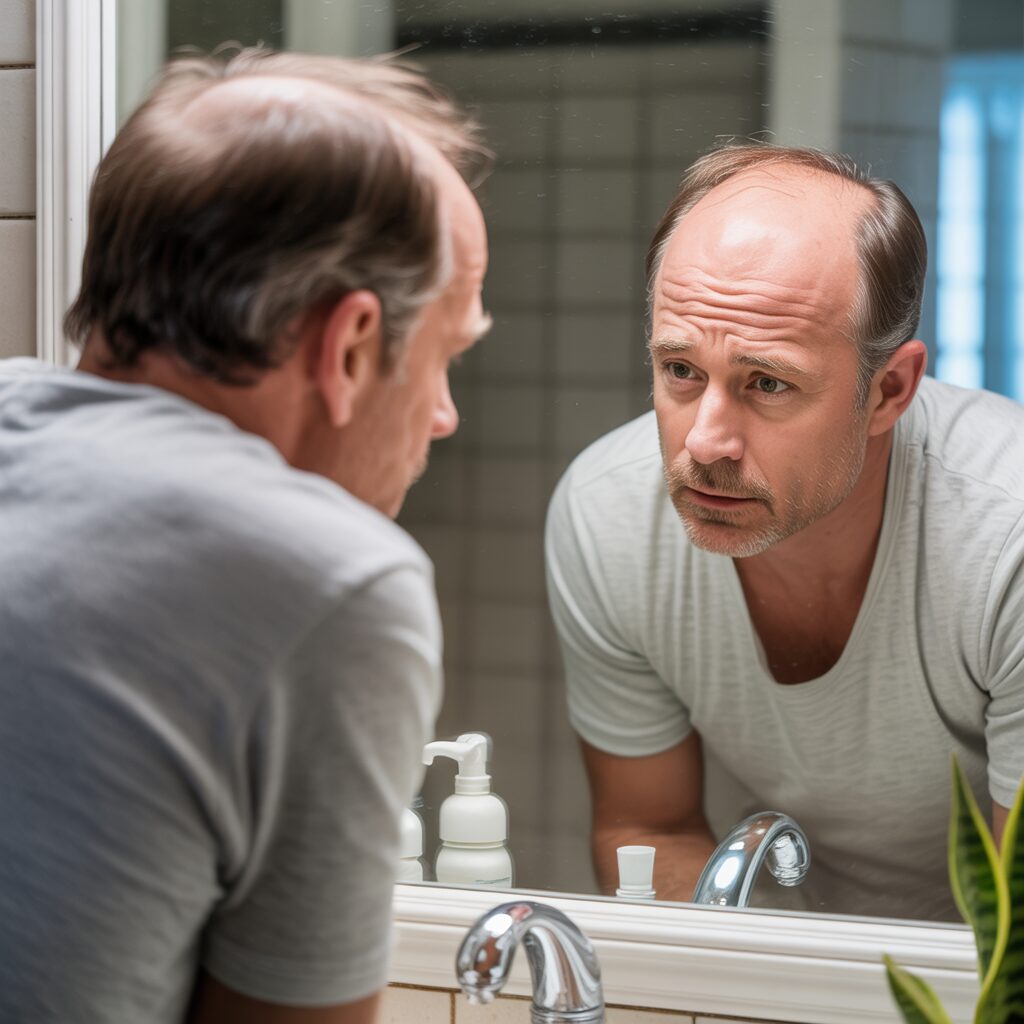
A. Common causes of hair loss in men
Finding more hair on your pillow lately? You’re not alone. Millions of men face this issue, and it’s often due to these main culprits:
DHT (Dihydrotestosterone): This hormone is public enemy #1 for your hair. It shrinks follicles until they stop producing hair altogether.
Stress: Your body’s fight-or-flight response can push hair follicles into a resting phase, causing noticeable shedding weeks later.
Poor Diet: Skip the nutrients your hair needs, and it’ll show. Iron, protein, and vitamin deficiencies all take their toll.
Medications: Certain drugs for blood pressure, depression, and arthritis list hair loss as a side effect.
Medical Conditions: Thyroid problems and autoimmune diseases often announce themselves through your hair first.
B. Distinguishing between normal shedding and thinning
Freaking out about hair in the shower drain? Hold up.
Normal shedding (50-100 hairs daily) happens to everyone. Thinning is different – you’ll notice:
- Visible scalp where hair used to be dense
- Smaller ponytail thickness (if you wear one)
- Receding hairline, especially at the temples
- Hair that doesn’t grow as long as it used to
- Overall decreased volume
The mirror test doesn’t lie: take photos of your crown and hairline every few months to track changes.
C. The role of genetics in male pattern baldness
Blame your ancestors for this one. Male pattern baldness (androgenetic alopecia) is written in your DNA. Here’s the scoop:
The baldness gene isn’t just from mom’s side – that’s an old wives’ tale. Both parents contribute to your hair fate. If your father and grandfather went bald, your odds increase dramatically.
This genetic blueprint determines:
- How sensitive your follicles are to DHT
- Your pattern of hair loss (crown, temples, or both)
- When thinning will start (some guys in their 20s, others in their 40s)
- How rapidly you’ll lose hair
D. Age-related hair changes
Getting older means your hair changes – even if you don’t go bald. As years pass:
- Hair growth cycles shorten
- Individual strands become finer and less pigmented
- Growth speed decreases (that’s why older men need fewer haircuts)
- Natural oils decrease, making hair drier and more brittle
By age 50, half of all men have noticeable thinning. It’s a natural process, but that doesn’t mean you can’t fight back with the right approach.
Nutrition-Based Remedies
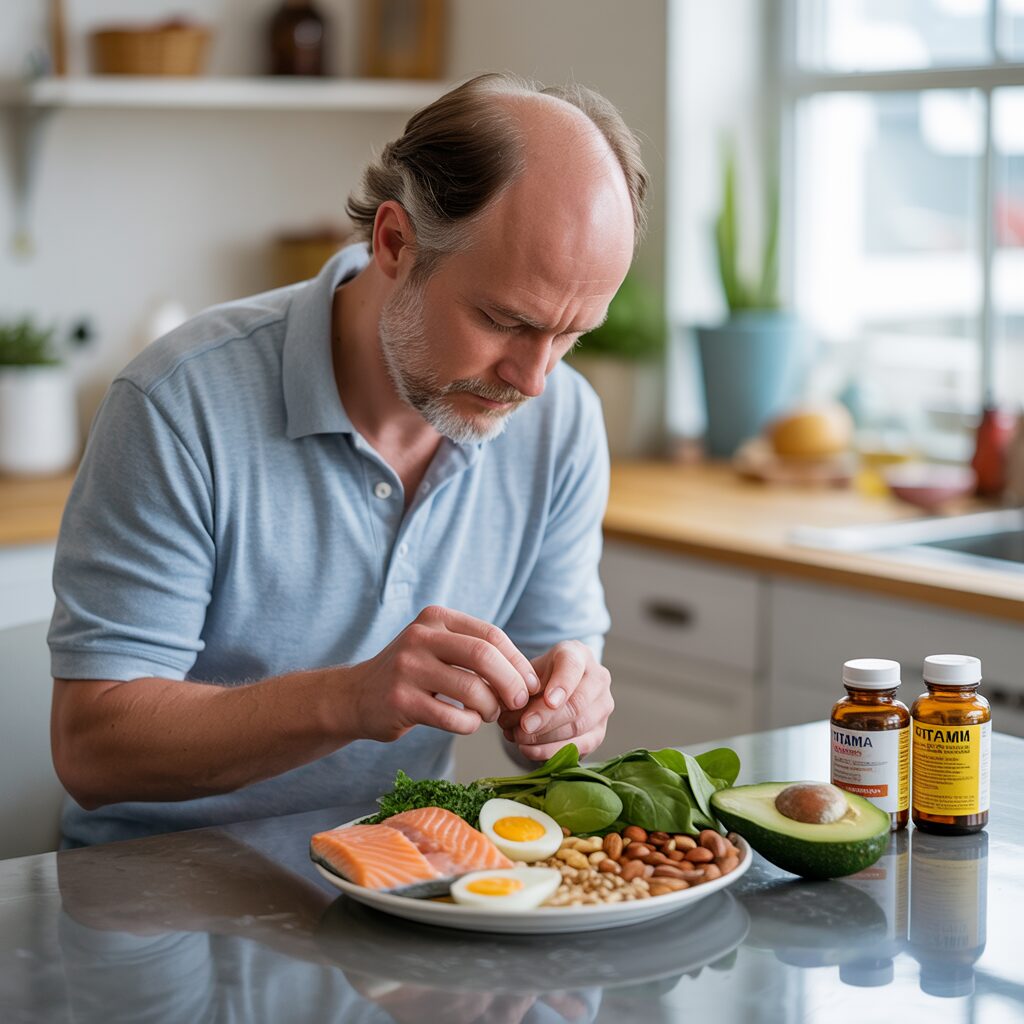
A. Essential vitamins that promote hair growth
Your hair is literally starving for certain vitamins. Biotin (vitamin B7) is basically hair food – it builds the protein keratin that forms your hair structure. Men seeing results typically take 2,000-5,000 mcg daily.
Vitamin D deficiency? That might explain your thinning crown. Studies show balding men often have lower vitamin D levels. Get yours checked.
Don’t skip vitamin A either – it helps your scalp produce sebum, the natural oil that moisturizes your follicles. But careful: too much can actually cause hair loss.
Vitamin E improves circulation to your scalp, and vitamin C helps your body absorb iron while fighting oxidative stress that ages your hair prematurely.
B. Minerals that strengthen hair follicles
Zinc deficiency hits your hair hard. This mineral helps repair and grow tissue, and men losing hair often have low zinc levels. Pumpkin seeds, oysters, and beef give you natural zinc boosts.
Iron carries oxygen to your hair cells. Without enough, your follicles literally suffocate. Many guys don’t realize they’re running low.
Selenium protects against oxidative damage, while magnesium fights inflammation that can choke off hair growth.
C. Protein-rich foods for healthier hair
Hair is 95% protein. Not eating enough? Your body will literally shut down hair production to conserve resources.
The harsh truth – most guys need more quality protein. Eggs deliver complete proteins plus biotin and B12. Lean meats provide iron with your protein. Plant-based? Combine legumes with whole grains for complete amino acid profiles.
D. Omega-3 fatty acids and their benefits
Your hair’s secret weapon? Omega-3s. These fatty acids nourish hair follicles, add shine, and reduce inflammation at the root level.
Most guys get way too many omega-6s (inflammatory) and not nearly enough omega-3s (anti-inflammatory). Fatty fish like salmon and mackerel deliver the most bioavailable forms. Plant sources like flaxseed and walnuts work too, but your body converts them less efficiently.
Regular omega-3 consumption makes hair noticeably thicker within 3-6 months for many men.
E. Anti-inflammatory foods that reduce hair loss
Chronic inflammation is silently killing your hair follicles. Turmeric contains curcumin, one of nature’s most powerful anti-inflammatories. Just a teaspoon daily can help.
Green tea provides catechins that specifically target DHT, the hormone responsible for male pattern baldness.
Colorful berries load you with antioxidants that fight oxidative stress, while nuts and seeds deliver vitamin E alongside healthy fats that calm inflamed scalps.
Herbal Solutions for Hair Regrowth
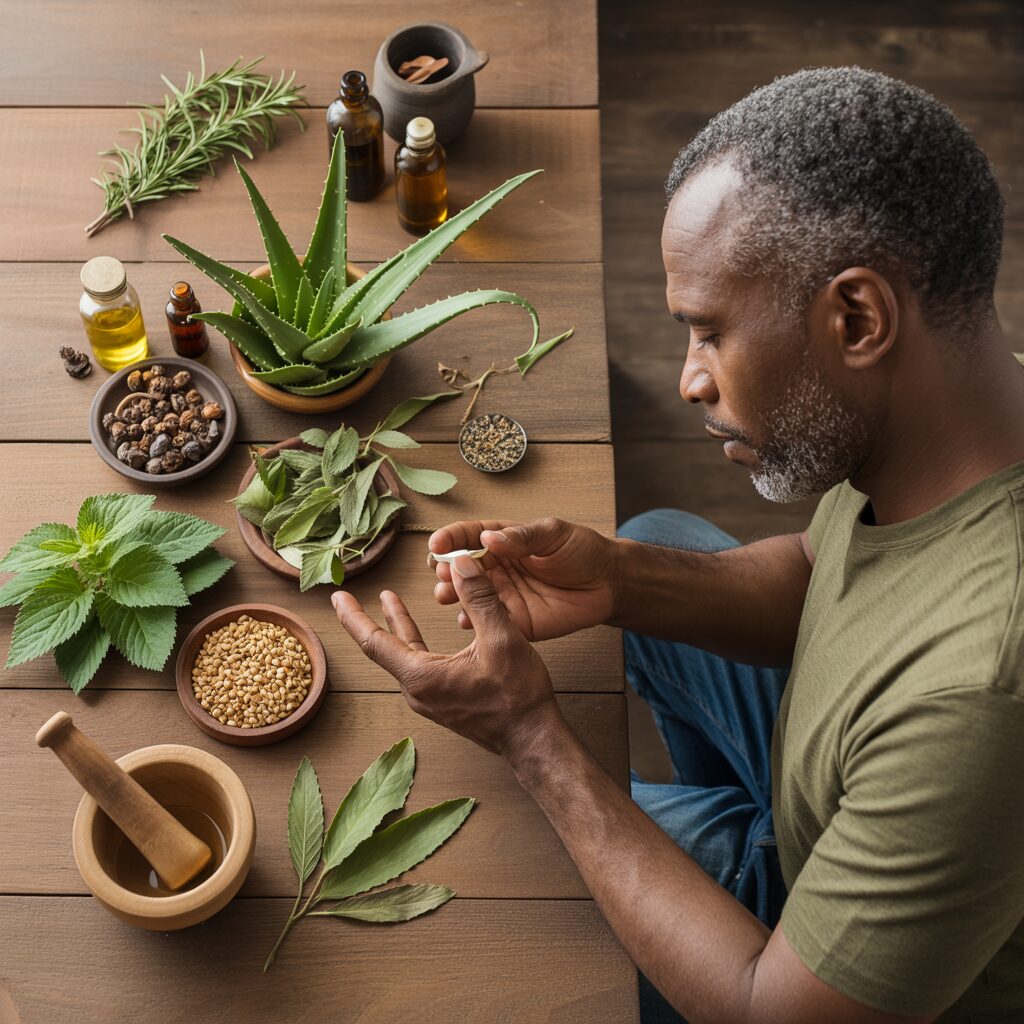
A. Saw palmetto for blocking DHT
Guys, if you’re noticing more hair in the drain than on your head, DHT might be the culprit. This hormone literally shrinks your hair follicles until they stop producing hair. Enter saw palmetto – nature’s DHT blocker.
This little berry packs a serious punch. Research shows it can inhibit up to 32% of DHT production. That’s huge! Unlike prescription medications, saw palmetto typically causes fewer sexual side effects while still helping to preserve your hairline.
Most men see results with 320mg daily, either as a supplement or applied directly to the scalp in oil form. You’ll need patience though – give it at least 3-4 months before expecting visible changes.
B. Rosemary oil treatments
Rosemary oil isn’t just for cooking. This potent herb stimulates blood circulation to your follicles and has been scientifically compared to minoxidil (the active ingredient in Rogaine) with similar results. No joke.
Here’s how to use it: Mix 10-15 drops with a carrier oil like jojoba, massage into your scalp, leave it for 30 minutes, then wash out. Do this 2-3 times weekly. Or add 5 drops to your shampoo bottle for daily use.
The menthol-like tingle you feel? That’s increased blood flow delivering nutrients to hungry hair follicles. Plus, it smells way better than most hair treatments.
C. Pumpkin seed oil benefits
Pumpkin seed oil deserves way more credit in the fight against hair loss. In one study, men taking pumpkin seed oil supplements saw a 40% increase in hair count after 24 weeks. Those are results you can’t ignore.
The secret lies in its phytosterols that block enzymes that convert testosterone to DHT. It’s also loaded with zinc, magnesium and antioxidants that support overall hair health.
Take 1000mg daily as a supplement or mix a tablespoon into smoothies. For topical application, warm a few drops between your palms and work it into your scalp before bed (use a shower cap to protect your pillowcase).
D. Ginseng extracts for circulation improvement
Your hair follicles are basically tiny plants that need good soil and circulation to thrive. Ginseng supercharges blood flow to your scalp, delivering oxygen and nutrients to those hungry follicles.
Korean red ginseng particularly stands out for hair regrowth. It contains ginsenosides that stimulate scalp skin cells and strengthen the hair root. Many guys report less shedding within weeks of starting a ginseng regimen.
Try taking 500-1000mg daily as a supplement, or look for shampoos and tonics containing ginseng extract. For an intensive treatment, steep ginseng tea, let it cool, and use it as a scalp rinse after shampooing.
Scalp Care Techniques
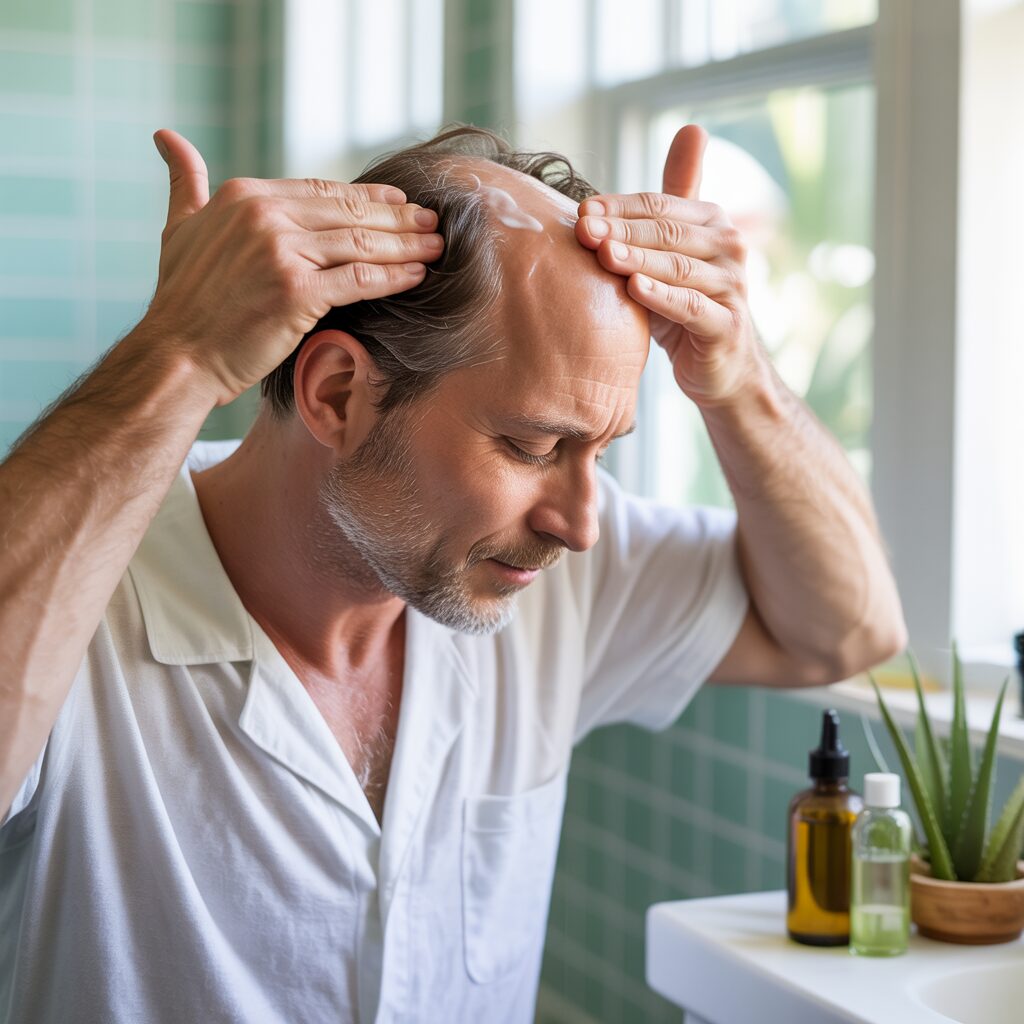
A. Effective massage methods to stimulate growth
Guys, your scalp needs blood flow to grow healthy hair. Think of it like watering a plant – no water, no growth. A daily 5-minute massage can wake up those sleeping follicles.
Try these techniques:
Fingertip Pressure – Using your fingertips (not nails!), apply firm pressure in small circular motions. Start at your temples and work toward the crown.
Knuckling Method – Make loose fists and use your knuckles to gently drum across your scalp. This deeper pressure reaches follicles that fingertips might miss.
Spider-Claw Technique – Spread your fingers wide, place them on your scalp, and gently squeeze and release. Move in sections from front to back.
The best time? Right after showering when your scalp is clean and relaxed. Or before bed to help you chill out while boosting hair health.
B. Natural exfoliation for removing buildup
Your scalp is suffocating under product buildup, dead skin and excess oil. This gunk blocks new hair growth like concrete over grass seeds.
Ditch those harsh chemical scrubs. Try these instead:
Brown Sugar Scrub – Mix 2 tablespoons brown sugar with coconut oil until paste-like. Massage into damp scalp before shampooing.
Sea Salt Cleanse – Combine fine sea salt with olive oil. The salt removes dead cells while the oil prevents dryness.
Coffee Grounds Mix – Used coffee grounds mixed with argan oil makes an excellent exfoliant that stimulates circulation too.
Use these treatments once weekly – more will strip natural oils your hair needs.
C. Essential oil blends for healthier follicles
Essential oils aren’t just for making your bathroom smell good. They’re powerhouses for hair growth when used right.
Top performers for thinning hair:
Rosemary – Research shows it works as well as minoxidil for some guys. Dilute 10 drops in 2 tablespoons carrier oil.
Peppermint – Creates a cooling tingle that increases blood flow to follicles. Limit to 5 drops per application as it’s potent.
Cedarwood – Balances oil production while fighting fungal issues that might be causing hair loss.
My go-to blend: 5 drops rosemary, 3 drops peppermint, 4 drops cedarwood in 2 tablespoons jojoba oil. Massage in before bed three times weekly. Your pillowcase might smell like a forest, but your scalp will thank you.
Always do a patch test first – even natural oils can irritate sensitive skin.
Lifestyle Changes That Prevent Further Thinning
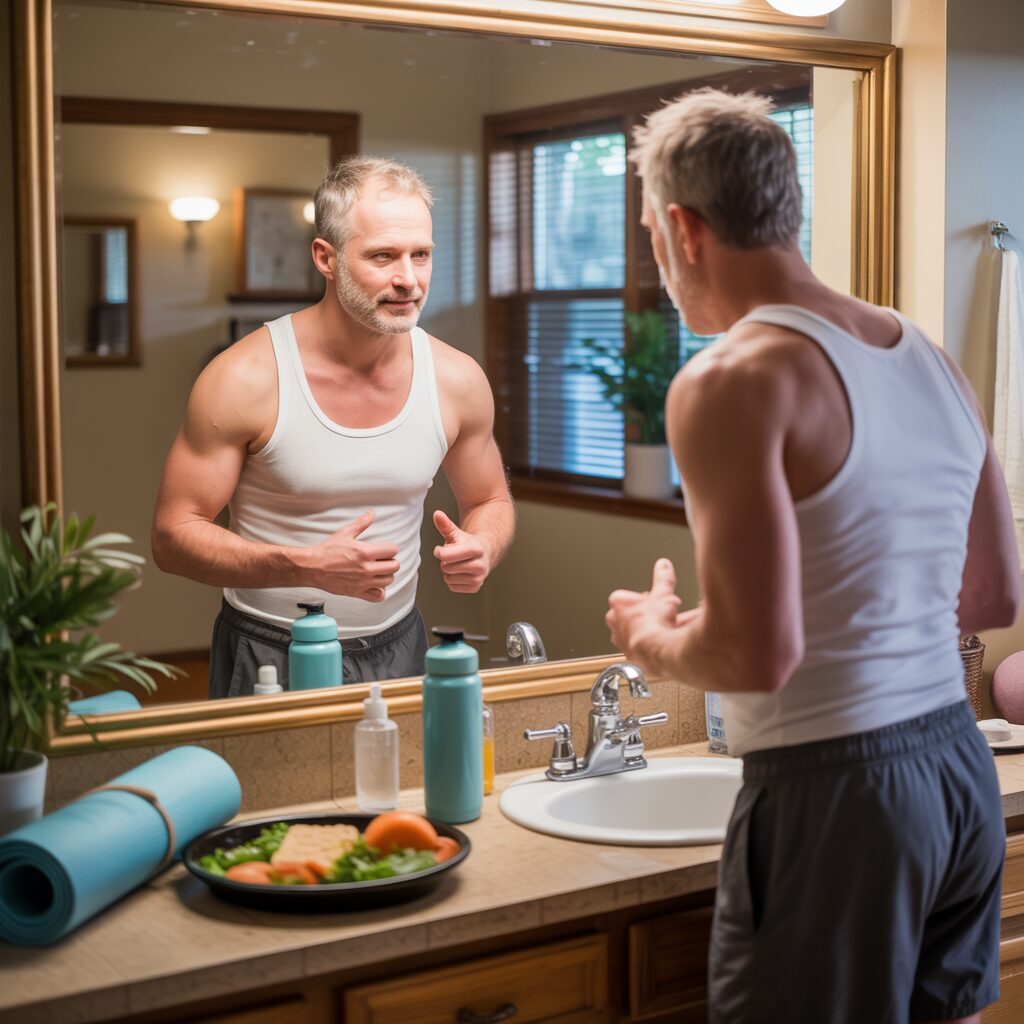
Stress Management Techniques
Hair thinning got you stressed? Well, that stress might be making your hair loss worse. Talk about a vicious cycle!
Meditation isn’t just for yogis. Just 10 minutes daily can slash cortisol levels – that nasty stress hormone that’s terrible for your hairline.
Deep breathing works too. Try the 4-7-8 technique: breathe in for 4, hold for 7, exhale for 8. Do this when traffic’s bad, your boss is annoying, or whenever life gets overwhelming.
Journaling before bed? Game-changer. Dump those racing thoughts onto paper instead of letting them circulate all night.
And don’t forget hobbies! Whether it’s fishing, painting, or tinkering with cars – regular breaks from the daily grind keep stress in check and your follicles happier.
Sleep Optimization for Hair Regeneration
Your body repairs itself during sleep – including your hair follicles.
Most guys don’t realize hair grows primarily at night when growth hormones kick into high gear. Aim for 7-9 hours of quality sleep. Those “I’ll sleep when I’m dead” bragging rights? They’re costing you your hair.
Create a sleep sanctuary: cool room (65-68°F), blackout curtains, and no blue light from phones at least an hour before bed.
Silk pillowcases aren’t just fancy – they reduce friction that damages hair. Cotton pillowcases can cause breakage and split ends that make thinning more noticeable.
Exercise Benefits for Hair Health
Breaking a sweat regularly improves circulation, delivering oxygen and nutrients straight to your scalp.
Cardio increases blood flow to follicles, while strength training optimizes testosterone levels – critical for maintaining healthy hair. Just 30 minutes, 3-4 times weekly makes a difference.
Post-workout, rinse your hair with cool water. Hot showers might feel amazing after leg day, but they strip natural oils your scalp needs.
Reducing Harmful Habits That Contribute to Hair Loss
That cigarette? It’s suffocating your hair follicles. Smoking restricts blood vessels, starving your scalp of nutrients.
Heavy drinking depletes zinc and B vitamins your hair desperately needs. Cut back to 1-2 drinks a few times weekly.
That baseball cap you never take off? It’s trapping heat and sweat against your scalp. Let your head breathe occasionally.
Harsh styling products with alcohols and sulfates are follicle killers. Switch to natural alternatives with ingredients you can actually pronounce.
Your diet matters too. Processed foods and excess sugar trigger inflammation that can disrupt the hair growth cycle. Small swaps like trading soda for water make a significant difference over time.
DIY Hair Treatments
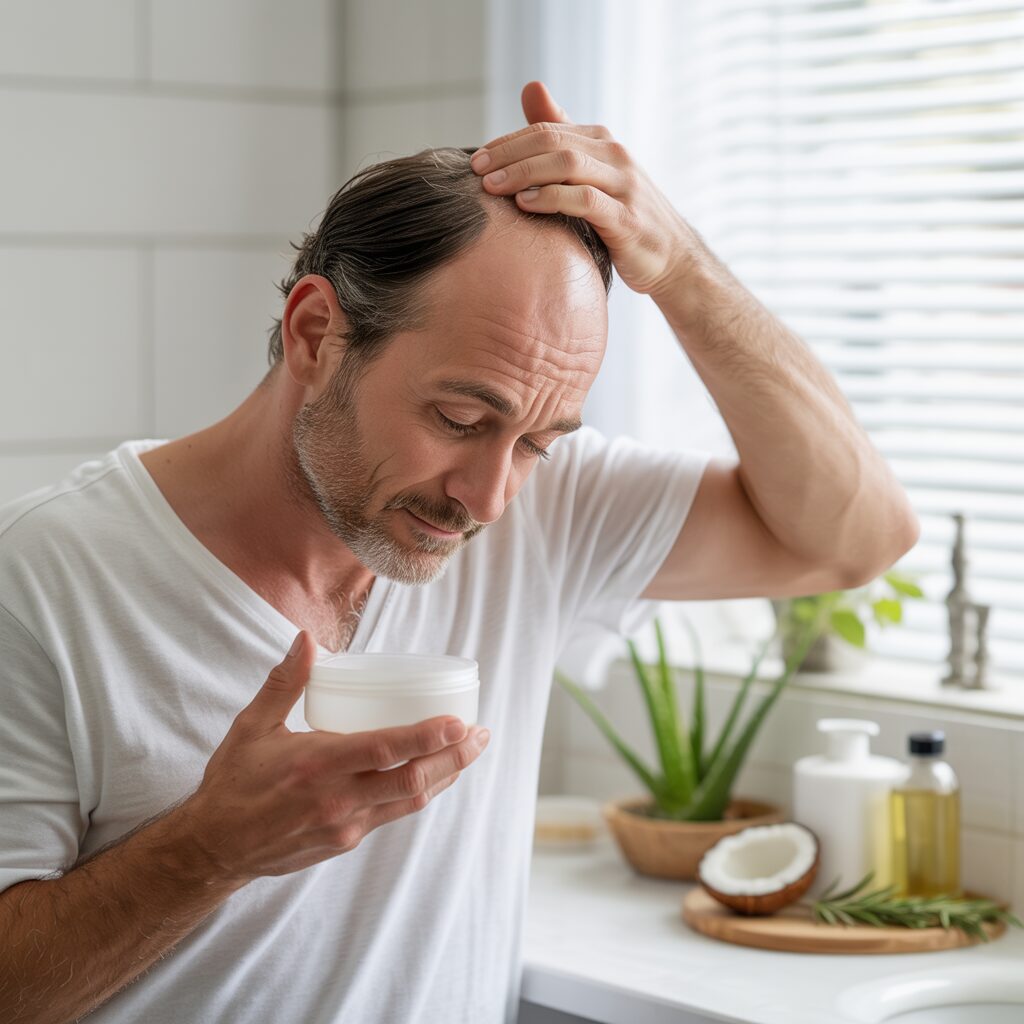
A. Egg and olive oil masks
Ever seen a guy with thick, lustrous hair and thought, “Man, what’s his secret?” Well, it might be as simple as raiding his kitchen. Eggs pack protein and fatty acids that strengthen your hair from root to tip. Olive oil? It’s basically liquid gold for your scalp.
Here’s a mask that works wonders:
- 1 whole egg (yolk and white)
- 2 tablespoons olive oil
- 1 teaspoon honey (optional for extra moisture)
Mix it up, massage into your scalp, and let it sit for 30 minutes. Your hair will drink this stuff up like it’s been stranded in a desert.
B. Aloe vera applications
Aloe vera isn’t just for sunburns. This miracle plant contains enzymes that promote healthy hair growth and reduce scalp inflammation.
Cut open an aloe leaf and scoop out the gel or grab some pure aloe vera gel from the store. Rub it directly onto your scalp, focusing on thin areas. Leave it on for 30-45 minutes before rinsing.
Do this three times weekly and you’ll notice less hair in your shower drain. Bonus? It feels incredibly cooling and refreshing—like your scalp just took a vacation.
C. Apple cider vinegar rinses
Your scalp’s pH balance matters more than you think. When it’s off, your hair suffers.
Mix one part apple cider vinegar with three parts water. After shampooing, pour this solution over your head and massage gently. Wait 5 minutes, then rinse thoroughly.
The smell is strong (not gonna lie), but it disappears once your hair dries. What doesn’t disappear? The shine, strength, and volume this simple rinse gives you.
D. Onion juice treatments
I know what you’re thinking: “Onion juice? On my HEAD?” Trust me on this one.
Onions contain sulfur compounds that boost collagen production for hair growth. They also have antibacterial properties that keep your scalp healthy.
Blend or juice an onion and strain the liquid. Apply directly to your scalp, leave for 15-30 minutes, then wash with a mild shampoo.
Yes, it smells. But the results? Totally worth holding your nose for a few minutes.
E. Green tea hair sprays
Green tea is loaded with antioxidants called catechins that block DHT, the hormone responsible for male pattern baldness.
Brew 2-3 tea bags in 1 cup of hot water. Let it cool completely, then pour into a spray bottle. After showering, spray directly onto your scalp and massage in. No need to rinse out.
Use it daily and within weeks, you’ll notice less shedding and more strength in existing hair. Plus, it’s refreshing and takes literally two minutes.
When to Combine Natural Remedies with Medical Approaches
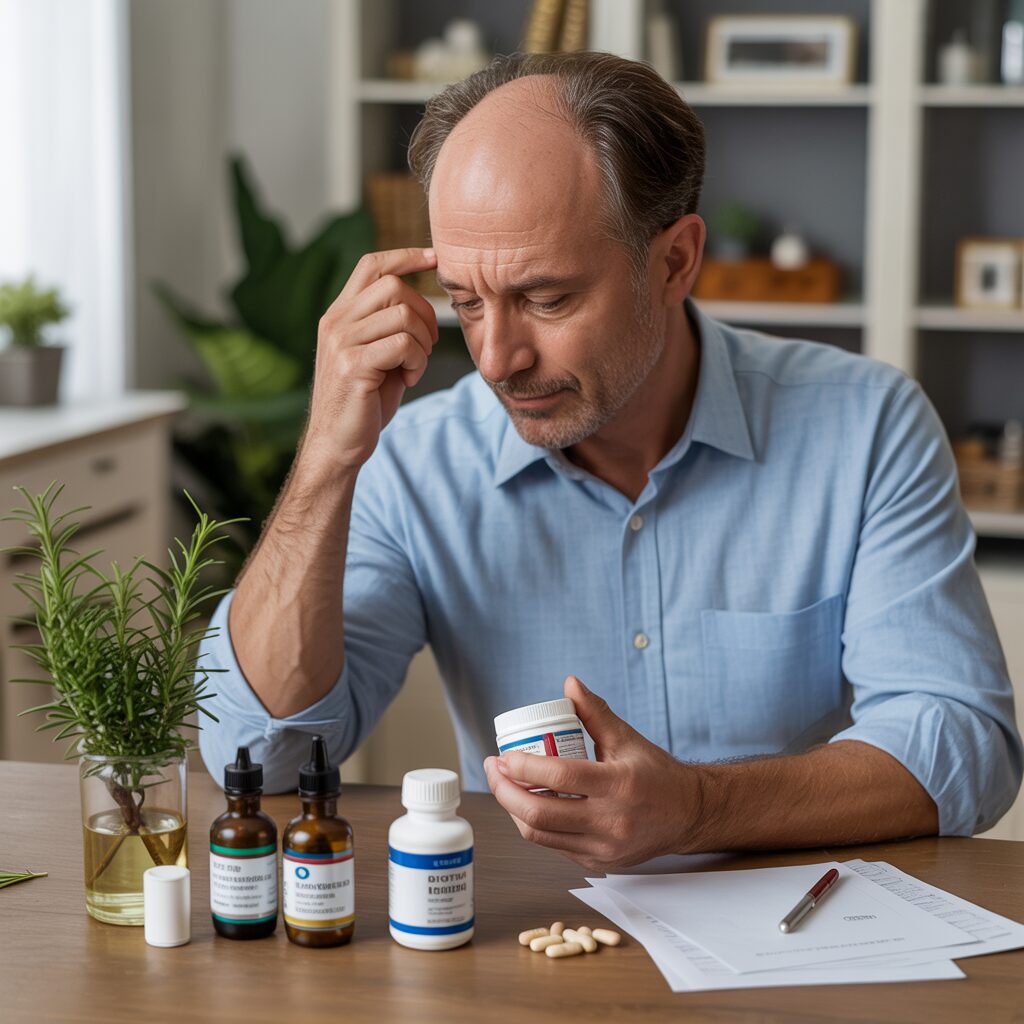
A. Timeline for expecting results from natural remedies
Natural remedies aren’t magic bullets. Most guys need to stick with them for at least 3-4 months before noticing any real difference. Your hair growth cycle takes time, and these natural approaches work gradually.
During the first month, you might notice less hair falling out in the shower or on your pillow – that’s your first win. By month two, some guys report their scalp feels healthier and less irritated. Real visible results typically show up around month three or four, when you might notice slightly thicker hair texture and maybe some baby hairs in previously thinning areas.
Remember though – everyone’s different. Your genetics, the severity of your thinning, and how consistently you apply these remedies all affect your timeline.
B. Warning signs that require professional attention
Stop relying solely on natural treatments if you notice:
- Sudden, dramatic hair loss (clumps falling out)
- Circular bald patches appearing randomly
- Severe scalp inflammation, redness, or pain
- Hair loss accompanied by unexplained weight loss or fatigue
- Any unusual scalp conditions like excessive scaling or oozing
These symptoms could signal underlying health issues that coconut oil masks and scalp massages simply can’t fix.
C. Complementary approaches to prescription treatments
Natural remedies can actually work alongside medical treatments rather than replacing them. Many guys find this combo approach gets them better results.
For instance, while using minoxidil (Rogaine), you can boost its effectiveness with rosemary oil massages on alternating days. If you’re taking finasteride, supporting it with a diet rich in biotin and zinc gives your body the building blocks needed for healthier hair.
The key is telling your doctor about all the natural remedies you’re using. Some herbs can interact with medications, and your doctor needs the complete picture to guide you safely.
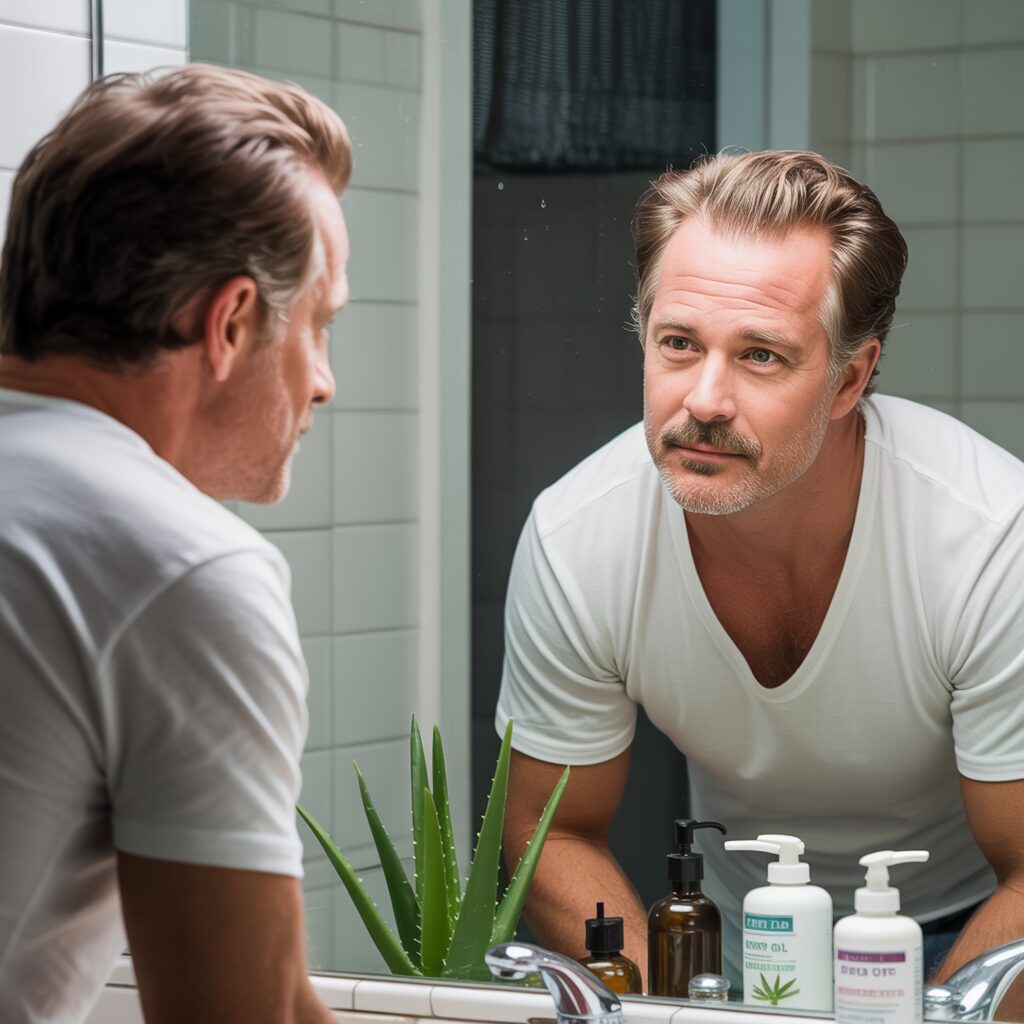
The journey to combat hair thinning doesn’t have to rely solely on commercial products. From nutrition-rich diets that nourish hair follicles to powerful herbs like saw palmetto and rosemary, nature offers numerous effective solutions. Proper scalp care techniques and thoughtful lifestyle adjustments—such as stress management and adequate sleep—create the foundation for healthier hair growth while simple DIY treatments can be crafted right in your kitchen.
Remember that consistency is key when using natural remedies for thinning hair. While these approaches offer gentle, sustainable options for many men, don’t hesitate to consult with a healthcare provider if you experience aggressive hair loss. The most successful strategies often combine natural treatments with medical advice when necessary, giving you the comprehensive approach needed to maintain your hair’s health and appearance for years to come.

